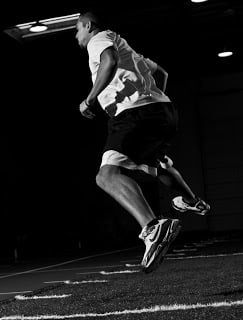
Most people are aware of a defensive slide in basketball, either from playing the sport or watching any movie with the coach endlessly drilling in the fine points of this position, specifically having the toes pointed in the direction of movement. In the heat of practice or a game, it is easy to accept or convey that the toes should point “where you are going”. My college strength told me to look up when I squat because that’s where I was going. But the truth is this foot position might actually increase injury risk. The position doesn’t matter if you are moving right or left.
Probably the biggest risk lies in the tracking of your knee. Most knee injuries, ranging from ACL rupture to tendonitis and anything in between, arise in some part due to abnormal tracking of the patella, the knee cap, as the body moves. So if you’re moving to your right, with your right foot pointed to that direction, what happens to your right knee tracking? There is no way to keep the right knee pointed to the right at the same angle as your foot, hence bad tracking and an increased knee injury risk.
This situation worsens with the population of basketball players. After a decade of experience training all different types and levels of athletes, there is no one group more inflexible due to their endless reps of running and jumping. So the tight tissue on the outside of the kneecap only makes improper tracking more pronounced.
Another problem is muscular activation because one of the major hip stabilizers, the gluteus medius, is an internal rotator, so pointing the toes out will inactivate this muscle that has been proven over and over again to protect joints. Your best option to maximize this muscle’s ability to push for a powerful slide, not to mention prevent that knee from diving inwards, is to always keep the feet pointed straight ahead, regardless of your movement direction.
The game of basketball, or any non-baseball sport, is not static, you are constantly moving and flowing to where the ball and opponent is on the court. Having the toes pointed straight ahead will also allow a safer and quicker transition to a vertical jump, or even a sprint ahead for a loose ball.
This principle of lateral movement, ensuring proper tracking by keeping the feet pointed straight ahead, applies to all sports. You won’t see tennis players waiting for a serve with both feet pointed out, some of the greatest home run hitters like Barry Bonds have even exaggerated the opposite by pointing the toes inward for more power. So always keep those feet pointed straight ahead, you never know what will happen next.